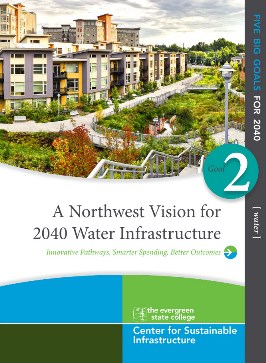Much of the water infrastructure in the Pacific Northwest of the United States is old, at risk for breakdowns, and vulnerable to threats including earthquakes and climate extremes, according to a new report. But the region’s water utilities can generate solutions by adopting new investment practices for billions of dollars in annual spending, guided by long-range vision and strategy.
The new report, A Northwest Vision for 2040 Water Infrastructure: Innovative Pathways, Smarter Spending, Better Outcomes, by The Evergreen State College’s Center for Sustainable Infrastructure (CSI), was developed with collaboration of 50 industry experts spanning water supply, wastewater, and stormwater infrastructure. The report is the first attempt to construct a regional shared vision for the future of water infrastructure in the Northwest.
A Northwest Vision for 2040 Water Infrastructure highlights a wide range of leadership examples, such as Portland’s Bureau of Environmental Services, which saved $63 million on a sewer overhaul project with green infrastructure, much of it on customer properties. The small rural community of Orting, Washington – facing an urgent need to replace aging dikes and levees – developed a cost-effective strategy to restore natural river flow and wetlands, resulting in not only improved flood protection, but better habitat for salmon, and new green space and recreational trails for the community.
The report also recommends cost-sharing agreements that leverage multiple interests in green infrastructure, from water to recreation, wildlife and health. The report points to a leading example, Clean Water Services (CWS) of Hillsboro, Oregon. CWS averted a $60-$150-million treatment plant investment with a streamside restoration investment into which it put $4.3 million, while drawing millions more from state and federal partners with water and wildlife interests.
The report comprehensively overviews the wide-ranging and unprecedented challenges facing the region’s water utilities, and highlights innovative solutions being pioneered by both big and small utilities on the West Coast. A Northwest Vision for 2040 Water Infrastructure paints a picture of how the region can develop cost-effective, integrated water systems that are among the most sustainable and resilient in the world. To achieve that goal, investment strategies will be required that break down silos within the water sector and build new partnerships beyond it, the report concludes. It offers working examples in the Northwest and beyond.
“Between now and 2040, the Northwest will spend billions of dollars year in and year out to maintain, operate and modernize water, wastewater, and stormwater infrastructure,” the report notes. “The multi-billion dollar question for the Northwest: How do we generate the most long-term community value from these investments?” Current spending to operate and maintain water infrastructure totals more than $3 billion a year in Washington and Oregon, but existing funds are unlikely to be enough to replace the vast network of aged pipes, pumps, and treatment facilities originally installed 40 years and more ago. Many assets are nearing or beyond their expected lifespan, leading to roughly 240,000 water main breaks and between 23,000 and 75,000 sanitary sewage overflows per year in the United States,” the National Infrastructure Advisory Council says. The council puts the investment gap at $400 billion to $1 trillion nationwide.
Meanwhile, climate disruption is changing rainfall and water supply assumptions on which long-term investment decisions are made. Northwest utilities face the added challenge of earthquakes that could cut off service for weeks.
On the other hand, a new portfolio of water infrastructure solutions is opening exciting new opportunities for innovation. Many of these new approaches can save money for the local utility, and also offer multiple benefits for health, environment, prosperity, and community.
Among changes the report overviews are:
- “Net water positive” buildings that capture, treat and recycle water on site;
- Green infrastructure investments, from rain gardens, street bioswales, and engineered wetlands to broader watershed restoration measures;
- Smart devices diffused throughout systems that provide managers with new tools to control flows.
The Evergreen State College created the Center for Sustainable Infrastructure (CSI) to champion a new infrastructure investment paradigm by centering on long-range strategic foresight, new decision tools, and integration across systems for broadly-shared, long-term community value. This is the third in a series of six reports CSI is producing to comprehensively detail an overall 25-year vision and pathway for Northwest infrastructure investment. Evergreen is a progressive, public liberal arts and sciences college located in Olympia, Washington, in the beautiful Pacific Northwest.

